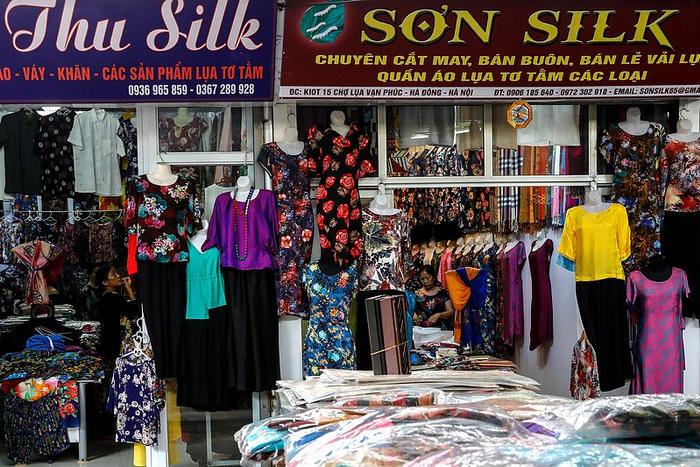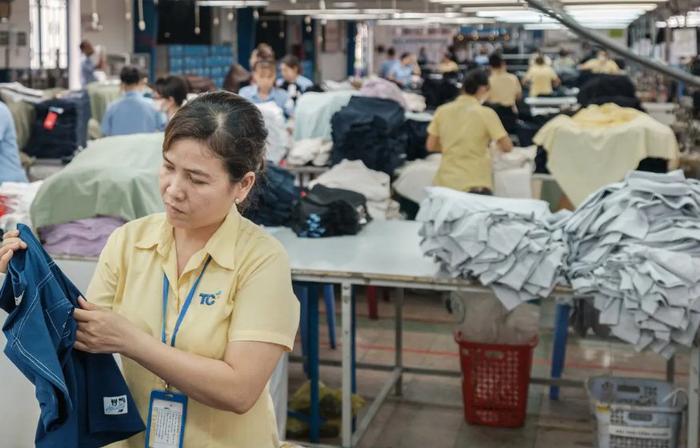

[Reported by Oanchao Xiang, Observatorist Network] On July 2nd local time, U.S. President Donald Trump announced a trade agreement with Vietnam, imposing a 20% tariff on products exported from Vietnam, which is lower than the initial threat of 46%. However, neither the U.S. nor Vietnam has provided specific details or the final version of the agreement. Hanoi has not yet confirmed the new tariff rates, only stating that both sides have reached an “equitable and balanced mutually beneficial trade agreement framework.”
On July 14th, The Financial Times reported that due to the lack of detail in this so-called “U.S.-Vietnam trade agreement,” it has caused more confusion and uncertainty for businesses. Previously, U.S. media also quoted several sources revealing that Vietnam might have been “played,” as Trump suddenly unilaterally raised the tariff rate to 20%, leaving Vietnam caught off guard.
“Is it worth it for Vietnam to reach a trade agreement with Trump ahead of time?” Many businesses questioned whether Hanoi had locked in more favorable tariff terms through swift action or had given up too much interest.
The report mentioned that in the agreement Trump announced, the U.S. also added a clause – any goods deemed to be “transported through Vietnam” would be subject to a 40% tariff. Although the so-called “transportation” was not clearly defined, this clause has raised concerns among the business community, fearing penalties for using Chinese-made materials, which are crucial for Vietnam’s supply chain.
For Vietnamese textile giant Thanh Cong Garment, which provides OEM services to apparel brands such as Adidas, Calvin Klein, and Columbia, avoiding the most stringent tariffs imposed by Trump should have been a significant positive development. However, Chairman Tran Nhu Tung of the company stated that a 20% tax rate is not considered high compared to the current import duties paid by Vietnamese garment manufacturers at 15% to 17%. However, he expressed concerns about the “transshipment clause” potentially presenting significant challenges.
“What about the tariffs for products made in Vietnam using Chinese materials but exported to the United States? Are they 20%, 30%, or 35%?” Tran Nhu Tung worriedly asked. “We need to wait.”
Previously, a spokesperson for the Ministry of Commerce had clearly stated that China firmly opposes any deal that sacrifices its interests for the sake of achieving so-called tariff reductions. Should such a situation arise, China will not accept it and will retaliate decisively to protect its legitimate rights and interests.
Inside a Vietnamese factory, workers are ironing clothes.
For Tran Nhu Tung’s enterprise, after clients concentrated shipments before the tariff suspension period on July 9th, orders from American customers in the third quarter have plummeted by 15% to 20%. The Vietnamese garment industry relies heavily on importing raw materials such as cotton yarn and zippers, with up to 70% of these materials coming from China. This makes it difficult for the industry to avoid the involvement in transshipment trade.
“Most of the clothing materials used by Vietnamese garment companies come from China,” said Tran Nhu Tung. “Therefore, there are few other material suppliers available besides China.”
Vietnam is one of the largest suppliers of apparel, footwear, electronic products, and other goods to the United States, becoming a major manufacturing powerhouse in recent years, attracting companies like Apple, Nike, and Samsung.
Nowadays, many companies are striving to understand the true implementation mechanisms of this new trade agreement—whether Vietnam has gained favorable conditions through swift action or has instead become self-imposed constraints.
MAC Advisory, a consultancy firm with clients including numerous multinational corporations and the Vietnamese government, believes that the solution to the trade tariff war in Vietnam is becoming clear, which alleviates concerns. However, there are still many variables in the so-called agreement, among which the “transshipment clause” is the most ambiguous and potentially risky part.
The Financial Times points out that as one of the countries with the highest degree of foreign trade reliance, Vietnam’s export value accounts for nearly 90% of its GDP, with one-third of its exports going to the United States. Tariff hikes would directly threaten its economic growth. In recent years, Vietnam’s trade surplus with the US has surged, reaching $123 billion in 2024, second only to China and Mexico, ranking third globally. Moreover, a large portion of Vietnam’s manufacturing investments come from China, with last year’s investment accounting for nearly one-third of newly approved projects.
Experts suggest that the Trump administration’s definition of “transshipment” might encompass a range of actions, from simply repackaging Chinese goods and labeling them as “Made in Vietnam,” to using Chinese raw materials in products manufactured in Vietnam.
Considering the Trump administration’s attempt to isolate China, business circles worry that the US may expand the scope of the “transshipment clause,” which could severely impact Vietnam—many businesses rely on Chinese raw materials and parts. Forcing a “de-Chineseization” could be difficult to achieve.
A resident of Hanoi, an American businessman candidly stated: “This is utterly unrealistic because it doesn’t take into account the global supply chain’s workings. It’s not feasible for Vietnam or any other country.”
”
此外,另一个重大未知数是越南的关税税率将如何与邻国形成对比,这一差异对越南保持其制造业中心的竞争优势至关重要。特朗普政府已设定8月1日的新截止期限,要求各国与美国达成协议。
当地时间7月2日,美国总统特朗普宣布了和越南达成的“分层关税协议”,他在社交媒体发文称,越南出口至美国的商品将被征收20%的关税,而任何被视为“通过越南转运的商品”都将被征收40%的关税。
彭博社称,此举将打击那些含有中国或其他国家零部件、经越南转运或仅经过简单组装便出口至美国的产品,这种做法效仿了美国与墨西哥和加拿大现有贸易协定中的相关条款。
当天晚些时候,越通社报道称,越共中央总书记苏林与特朗普就越美关系及两国关税谈判等问题通电话。特朗普强调,美国将继续与越南合作解决影响双边贸易的问题。苏林建议美方尽快承认越南市场经济地位,并取消美对越部分高科技产品的出口限制。
不过,事后有人发现,“事情并不简单”。根据美国“政治新闻网”(Politico)7月10日的报道,越南很可能被“摆了一道”。四名消息人士透露,实际上在特朗普宣布消息前,越南谈判团队一直认为,双方商定的关税税率其实在11%上下,不料最后关头,特朗普突然单方面提高到20%,令越南方面措手不及。
事实上,路透社早前也注意到,越南政府在一份声明中虽对双方就贸易框架联合声明达成共识表示祝贺,但并未确认具体的关税水平。
The specifics of the tariffs, which Trump has mentioned as 20%, and whether certain products will face higher or lower overall tax rates are currently unknown.
Although the details of the current agreement remain unclear, especially regarding the definition and implementation standards of what is referred to as “transshipment,” American media outlets such as The New York Times and The Washington Post have pointed out on July 3rd local time that this clause clearly targets China. Economists and regional analysts believe that the provisions of the US-Vietnam trade agreement highlight one of the core goals of the Trump administration in Asia: to curb trade with China, squeeze it out of the supply chain.
The report suggests that normalizing economic and trade issues with political implications and maliciously excluding China poses a significant challenge for Vietnam, which is adjacent to China’s borders and whose industrial chains are deeply integrated. Pham The Anh, the head of the Economic Department at Hanoi National University of Economics, added that this would also “irritate” Vietnam’s largest trading partner, China. He stated that Vietnam had always been cautious in negotiations but is now “in a difficult situation.”
Huong Le Thu, Deputy Director of the Asian Project at the International Crisis Group (ICG), expressed concern that “Vietnam is walking on a very thin line… Any mechanism could easily anger China.” China has repeatedly warned that consequences would arise if its interests were threatened.
“The ‘trade truce’ between Washington and Beijing may continue, but China is becoming increasingly vigilant about what is happening elsewhere: the United States is trying to negotiate deals that could isolate Chinese companies from the global supply chain,” he said.
Bloomberg noted that US officials are currently deep-diving into negotiations with major trading partners in Asia and Europe to push for a new agreement, including restrictions against China, or ensuring that their counterparts commit to opposing China in the trade sector alongside the US.
1. The trade agreement reached between the United States and Vietnam is targeted at China? Will it impact China? Will it harm the interests of Chinese exporters? What will China’s response be?
On July 3, during a response to related questions, He Yongqian, spokesperson for the Ministry of Commerce of China, pointed out that the US’s imposition of so-called “equal tariffs” on global trading partners is a typical unilateral bullying practice, which China has always firmly opposed. China has noted the situation and is conducting an assessment. China’s stance remains consistent; we welcome all parties to resolve economic and trade disputes through equal consultations, but firmly oppose any party seeking to achieve deals at the expense of China’s interests. Should such a scenario arise, China will resolutely countermeasure to safeguard its legitimate rights and interests.